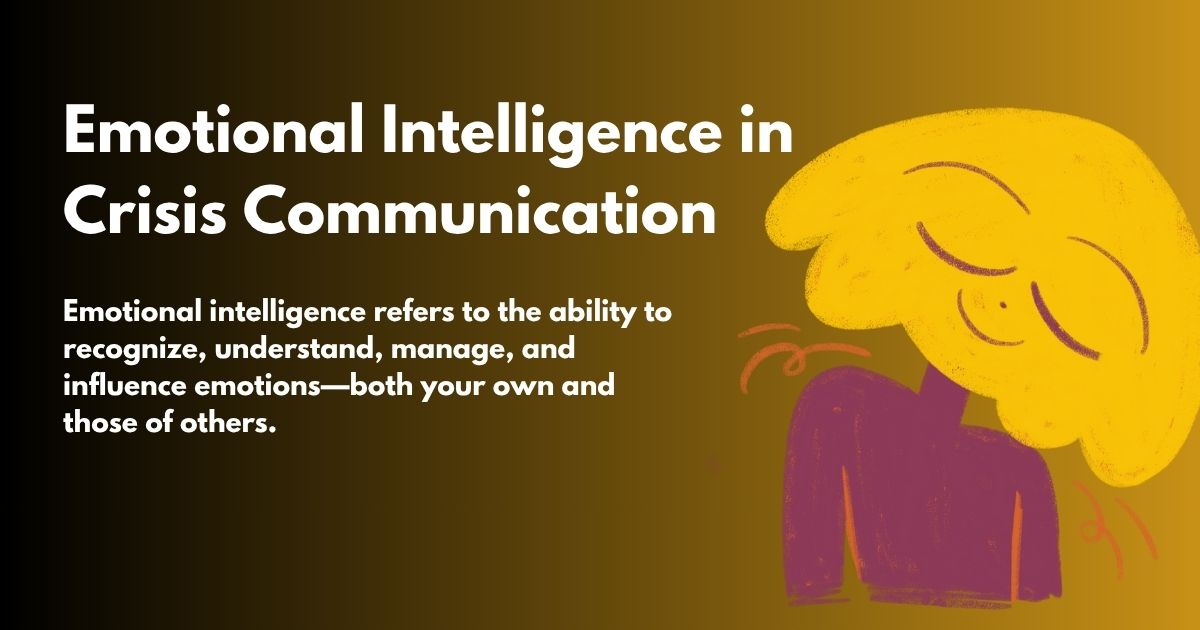
In a world filled with unpredictability, how leaders communicate during a crisis can define the outcome. One element that distinguishes effective communicators from others is emotional intelligence (EI). When crises arise—be it natural disasters, public relations issues, corporate scandals, or global pandemics—emotional intelligence can transform fear and confusion into clarity and trust.
This article explores how emotional intelligence plays a vital role in crisis communication, influencing everything from leadership tone to stakeholder response. We’ll break down its components, impact, and how leaders can cultivate this crucial skill to navigate turbulent times.
What Is Emotional Intelligence?
Emotional intelligence refers to the ability to recognize, understand, manage, and influence emotions—both your own and those of others. Psychologist Daniel Goleman popularized the concept, breaking it into five core components:
- Self-awareness – Recognizing your own emotions and their impact.
- Self-regulation – Managing emotions, especially in stressful situations.
- Motivation – Directing emotions toward goals with optimism and persistence.
- Empathy – Understanding others’ emotions and responding appropriately.
- Social skills – Managing relationships and building networks.
When applied to crisis communication, these traits help leaders deliver messages that resonate, calm fears, and maintain credibility.
Why Emotional Intelligence Matters in Crisis Communication
Crises often trigger panic, fear, anger, and confusion. An emotionally intelligent communicator doesn’t ignore these feelings—they validate them and respond with sensitivity.
Here are key reasons emotional intelligence enhances crisis communication:
- Builds Trust: Stakeholders are more likely to trust leaders who show genuine empathy and understanding.
- Strengthens Leadership: EI allows leaders to remain calm and composed, projecting confidence and competence.
- Improves Clarity: Emotionally intelligent leaders tailor their message to meet emotional needs, ensuring it’s heard and understood.
- Facilitates Collaboration: Teams are more cohesive when leaders manage emotional responses constructively.
- Mitigates Conflict: By recognizing emotional triggers, emotionally intelligent leaders can diffuse tension and resolve disputes quickly.
The Link Between Emotional Intelligence and Message Framing
During a crisis, message framing—how a message is constructed and delivered—is crucial. Emotional intelligence helps in framing messages in a way that balances realism with reassurance.
For example:
- Instead of saying, “We’re in trouble,” an emotionally intelligent leader might say, “This is a serious challenge, but we’re working on solutions.”
- Instead of dismissing fears with, “There’s nothing to worry about,” they acknowledge them: “We understand your concerns and are addressing them carefully.”
This subtle reframing maintains transparency without triggering panic, reflecting a deep understanding of human emotion.
Self-Awareness: The Foundation of Crisis Leadership

Self-awareness helps leaders assess how their emotional state influences their communication. In crisis moments, unchecked emotions like anger, fear, or frustration can lead to rash statements, misinformation, or misinterpretation.
Emotionally intelligent leaders:
- Reflect before reacting.
- Understand their emotional triggers.
- Stay mindful of their tone and body language.
For instance, during a press conference, a leader with high self-awareness will recognize their rising anxiety and take a moment to breathe or pause, ensuring their delivery remains composed.
Empathy: Understanding the Emotional Pulse of the Audience
Empathy is arguably the most critical EI component in crisis communication. It allows communicators to step into the audience’s shoes and tailor their message to the emotional climate.
Empathetic communication includes:
- Acknowledging people’s fears and frustrations.
- Using inclusive language like “we” and “together.”
- Listening actively to stakeholder feedback.
- Showing genuine concern through tone and action.
When leaders demonstrate empathy, it humanizes them, strengthens emotional connections, and enhances credibility.
Read our latest blog How to Write a Social Media Crisis Statement
Self-Regulation: Managing Emotional Responses Under Pressure
Crises can provoke intense emotional responses. Self-regulation helps leaders stay centered, avoiding reactive or emotional outbursts.
In crisis settings, self-regulation means:
- Avoiding defensiveness when criticized.
- Taking a thoughtful pause before responding.
- Responding to misinformation with patience rather than frustration.
- Using stress-reduction strategies to maintain composure.
By modeling calmness and resilience, leaders influence the emotional tone of the organization or community they lead.
Motivation and Purpose-Driven Messaging
Highly motivated leaders maintain focus and optimism, even in the face of adversity. They inspire others by emphasizing shared goals and long-term vision, even during short-term turmoil.
Purpose-driven crisis communication includes:
- Reinforcing organizational values.
- Offering hope and realistic optimism.
- Highlighting collective efforts and progress.
This inspires confidence and encourages unity in navigating the crisis.
Social Skills: Coordinating Teams and Managing Stakeholder Communication
Social skills are essential for navigating complex interpersonal dynamics in crisis scenarios. This includes:
- Clear and respectful communication.
- Conflict resolution.
- Negotiation with external stakeholders.
- Transparent dialogue with media and the public.
Emotionally intelligent leaders leverage social skills to align internal teams, coordinate responses, and communicate consistently across all channels.
Real-World Examples of Emotional Intelligence in Crisis Communication
Jacinda Ardern – New Zealand’s COVID-19 Response
New Zealand Prime Minister Jacinda Ardern was praised for her emotionally intelligent handling of the COVID-19 pandemic. Her empathetic tone, clarity, and consistency helped foster public trust. She acknowledged the public’s fears, provided clear direction, and communicated with both warmth and resolve.
Johnson & Johnson – Tylenol Crisis
In 1982, Johnson & Johnson’s response to the Tylenol poisoning crisis became a textbook example of crisis communication. The company’s leaders expressed empathy for victims, took immediate action, and communicated transparently—demonstrating emotional intelligence throughout the process.
These examples show how emotional intelligence can turn a potentially catastrophic situation into an opportunity for trust-building and leadership.
Building Emotional Intelligence for Crisis Readiness
Developing emotional intelligence isn’t instantaneous—it requires intentional practice and reflection. Here are strategies for leaders and communicators to enhance EI for future crises:
- Regular Self-Assessment: Use tools and feedback to gauge emotional awareness.
- Mindfulness Training: Techniques like meditation improve emotional regulation.
- Active Listening Exercises: Practice listening without interrupting or judging.
- Scenario Simulations: Rehearse crisis responses with a focus on emotional tone.
- Empathy Practice: Engage with diverse groups to broaden perspective-taking.
By embedding these practices, leaders become better equipped to manage both the logistical and emotional demands of crisis communication.
Emotional Intelligence in Digital Crisis Communication

With the rise of social media and digital communication, emotional intelligence must also extend to online platforms. Leaders must consider:
- Tone of Written Communication: Text lacks vocal tone and facial expression, so empathy must be conveyed explicitly through word choice.
- Timely Responses: A prompt, thoughtful reply can prevent misinformation from spreading.
- Managing Public Backlash: Responding with humility and empathy, rather than defensiveness, de-escalates online outrage.
Emotionally intelligent digital communication requires awareness of public sentiment and responsiveness tailored to diverse audiences.
Read our latest blog Social Media Crisis Management
Measuring the Impact of Emotional Intelligence in Crises
Though emotional intelligence is often seen as intangible, its impact can be measured through:
- Stakeholder trust surveys
- Employee morale indicators
- Media sentiment analysis
- Crisis recovery timelines
Organizations that integrate emotional intelligence into their crisis response tend to recover faster, retain stronger reputations, and maintain better stakeholder relationships.
Leading with Heart and Mind
Crisis communication isn’t just about words—it’s about connection. Facts are important, but without emotional intelligence, even the most accurate message can fall flat or create more panic. Leaders who combine strategic thinking with emotional insight foster resilience, trust, and unity.
As uncertainty continues to shape the global landscape, emotional intelligence will remain a non-negotiable skill for crisis communicators. It’s not just a tool—it’s a mindset that brings humanity back into high-stakes situations, guiding people through the storm with clarity, compassion, and conviction.



















No Comments